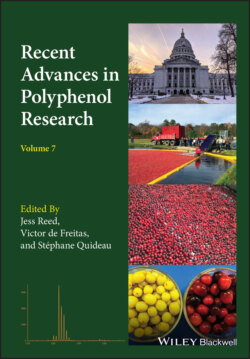Читать книгу Recent Advances in Polyphenol Research - Группа авторов - Страница 17
1.3.1 Reverse pH Jumps from Pseudo‐equilibrium Followed by Stopped Flow UV‐visible Spectroscopy
ОглавлениеRecently we have reported a new experimental procedure that allows the experimental determination of all equilibrium constants (as shown in Scheme 1.3) of the flavylium‐based multistates including anthocyanins (Mendoza et al. 2019; Mendoza et al. 2018; Slavcheva et al. 2018). It is based on the reverse pH jumps defined above, followed by stopped flow. In Figure 1.3 the stopped flow traces of the model compound 4’‐hydroxyflavylium are shown. The initial solutions should be equilibrated or pseudo‐equilibrated. The reverse pH jumps consist of the addition of acid to make the solutions with pH=1, where flavylium cation is the sole species. In both cases of Figure 1.3 the initial absorbance is due to the quinoidal bases (independently on their protonation state) that give flavylium cation (absorption at 450 nm) during the mixing time of the stopped flow together with some flavylium cation present at the initial equilibrium (at lower pH values) prior to the jump; see also Scheme 1.3. This is the reason why the mole fraction distribution of the flavylium cation and quinoidal bases are represented together in eq. (22). At the final very low pH jump (pH=1) the hydration reaction becomes faster than the tautomerization because it is directly proportional to the proton concentration (Pina 2014b). Therefore, the faster trace is due to the conversion of B into AH+. The slower trace is the formation of more flavylium cation from Cc via B (Scheme 1.4) (Mendoza et al. 2019).
In anthocyanins and most flavylium derivatives the cis‐trans isomerization is much slower than the other kinetic processes. It is possible thus to define a transient state (pseudo‐equilibrium) where the mole fraction of the trans‐chalcones is very small. Consequently, it is more convenient to carry out the reverse pH jumps from pseudo‐equilibrium. Scheme 1.4 illustrates the question in acidic medium, but it is generalized to higher pH values. Even if some Ct is formed, the only drawback is the loss of sensitivity, because the kinetics of the Ct transformation in flavylium cation is much slower and is not detected in the stopped flow experiments. In conclusion, the data reported in Figure 1.3, extended to other pH values, allows the calculation of the mole fraction distribution of the species A, B, and Cc as well as the respective anionic forms.
Figure 1.3 Stopped flow traces 4’‐hydroxyflavylium (at pseudo‐equilibrium, where no significant amounts of Ct were formed) after a reverse pH jump from pH=6.45 (a) and pH=8.9 (b) to the final pH=1.0.
Scheme 1.4 Energy level diagram of the compound 4’‐hydroxyflavylium and the kinetic processes after a reverse pH jump to pH≤1.
The mole fraction distribution of these species can be represented as a function of the initial pH of the reverse pH jump (Figure 1.4).
The fitting of Figure 1.4 was carried out by considering for AH+, CB^, CB^‐, and CB^2‐ the contributions of the respective forms of quinoidal bases, hemiketals, and cis‐chalcones. For example, the mole fraction distribution of CB‐^ is given by eq. (27) (Mendoza et al. 2019 supplementary information).
(27)
with
(28)
and
(29)
Figure 1.4 Representation of the mole fraction distribution of the compound 4’‐hydroxyflavylium on the basis that the reverse pH jumps at pseudo‐equilibrium. The symbol ^ is used to differentiate pseudo‐equilibrium from equilibrium (‘).
The mole fractions of the more colored forms, eq. (30), as well of those of hemiketals, eq. (31) and cis‐chalcones, eq. (31) are thus obtained.
(30)
(31)
(32)
Considering that the apparent equilibrium constants are experimentally obtained from the inflection points of the absorption spectra as a function of pH, the fitting of eq. (30) to eq. (32) permits us to obtain the constants an, bn and cn (n = 0, 1 and 2).
On the other hand, eq. (22) to eq. (25) can be re‐written for the pseudo‐equilibrium:
(33)
(34)
(35)
Comparing eq. (30) with eq. (33), eq. (31) with eq. (34), and eq. (32) with eq. (35) the following relations are obtained:
(36)
(37)
(38)
